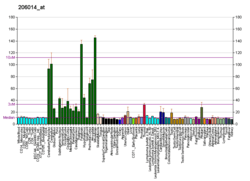ACTL6B
Actin-like protein 6B is a protein that in humans is encoded by the ACTL6B gene.[5][6]
Function
The protein encoded by this gene is a member of a family of actin-related proteins (ARPs) which share significant amino acid sequence identity to conventional actins. Both actins and ARPs have an actin fold, which is an ATP-binding cleft, as a common feature. The ARPs are involved in diverse cellular processes, including vesicular transport, spindle orientation, nuclear migration and chromatin remodeling. This gene encodes a subunit of the BAF (BRG1/brm-associated factor) complex in mammals, which is functionally related to SWI/SNF complex in S. cerevisiae and Drosophila; the latter is thought to facilitate transcriptional activation of specific genes by antagonizing chromatin-mediated transcriptional repression. This subunit may be involved in the regulation of genes by structural modulation of their chromatin, specifically in the brain.[6]
Interactions
References
- 1 2 3 GRCh38: Ensembl release 89: ENSG00000077080 - Ensembl, May 2017
- 1 2 3 GRCm38: Ensembl release 89: ENSMUSG00000029712 - Ensembl, May 2017
- ↑ "Human PubMed Reference:".
- ↑ "Mouse PubMed Reference:".
- ↑ Glöckner G, Scherer S, Schattevoy R, Boright A, Weber J, Tsui LC, Rosenthal A (December 1998). "Large-scale sequencing of two regions in human chromosome 7q22: analysis of 650 kb of genomic sequence around the EPO and CUTL1 loci reveals 17 genes". Genome Res. 8 (10): 1060–73. doi:10.1101/gr.8.10.1060. PMC 310788. PMID 9799793.
- 1 2 "Entrez Gene: ACTL6B actin-like 6B".
- ↑ Oma Y, Nishimori K, Harata M (February 2003). "The brain-specific actin-related protein ArpN alpha interacts with the transcriptional co-repressor CtBP". Biochem. Biophys. Res. Commun. 301 (2): 521–528. doi:10.1016/S0006-291X(02)03073-5. PMID 12565893.
External links
- Human ACTL6B genome location and ACTL6B gene details page in the UCSC Genome Browser.
Further reading
- Schafer DA, Schroer TA (2000). "Actin-related proteins". Annu. Rev. Cell Dev. Biol. 15: 341–363. doi:10.1146/annurev.cellbio.15.1.341. PMID 10611965.
- "Toward a complete human genome sequence". Genome Res. 8 (11): 1097–108. 1999. doi:10.1101/gr.8.11.1097. PMID 9847074.
- Harata M, Mochizuki R, Mizuno S (1999). "Two isoforms of a human actin-related protein show nuclear localization and mutually selective expression between brain and other tissues". Biosci. Biotechnol. Biochem. 63 (5): 917–923. doi:10.1271/bbb.63.917. PMID 10380635.
- Olave I, Wang W, Xue Y, Kuo A, Crabtree GR (2002). "Identification of a polymorphic, neuron-specific chromatin remodeling complex". Genes Dev. 16 (19): 2509–2517. doi:10.1101/gad.992102. PMC 187451. PMID 12368262.
- Kuroda Y, Oma Y, Nishimori K, Ohta T, Harata M (2003). "Brain-specific expression of the nuclear actin-related protein ArpNalpha and its involvement in mammalian SWI/SNF chromatin remodeling complex". Biochem. Biophys. Res. Commun. 299 (2): 328–334. doi:10.1016/S0006-291X(02)02637-2. PMID 12437990.
- Oma Y, Nishimori K, Harata M (2003). "The brain-specific actin-related protein ArpN alpha interacts with the transcriptional co-repressor CtBP". Biochem. Biophys. Res. Commun. 301 (2): 521–528. doi:10.1016/S0006-291X(02)03073-5. PMID 12565893.





